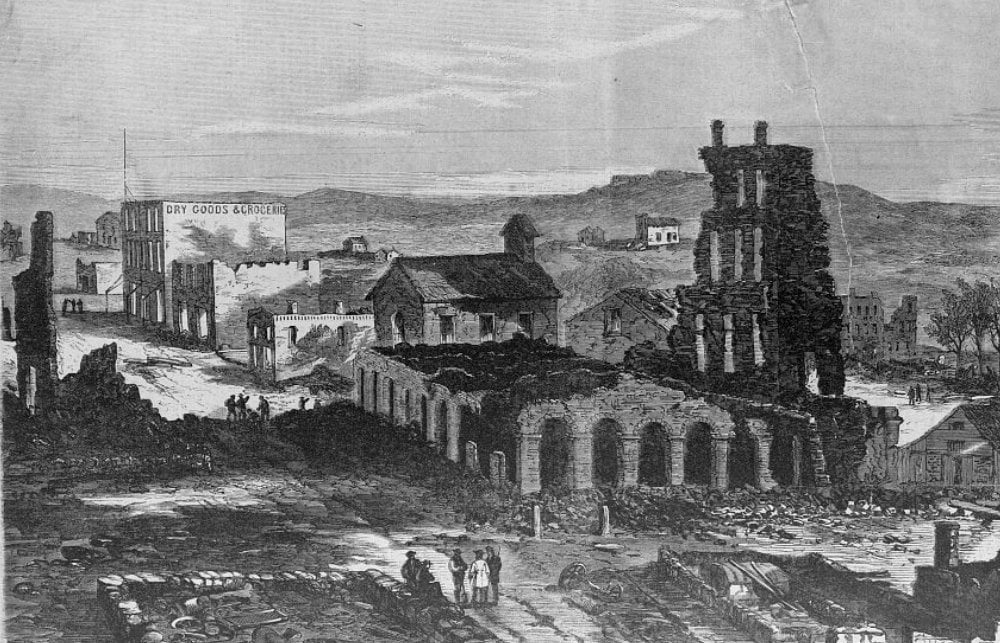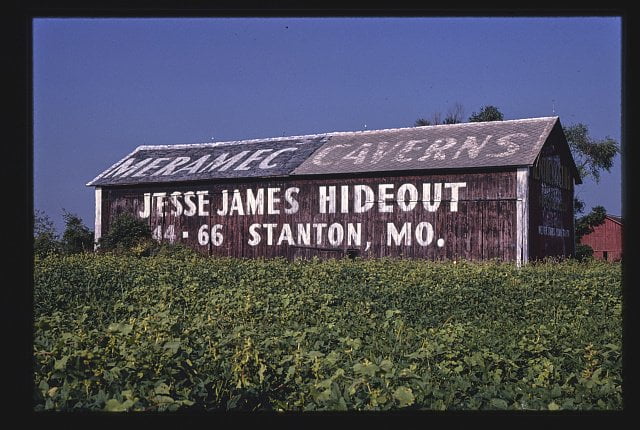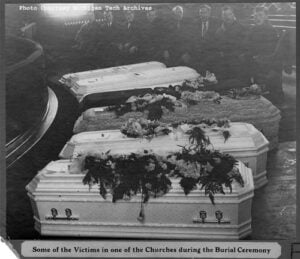How Civil War Atrocities Shaped Jesse James
Jesse James fought as a Confederate guerrilla fighter participating in some of the most gruesome acts of the Civil War.

exc-63b1d0706350f410410f916b
When people think of outlaws and the American West, Jesse James’ name often leads the pack. Known as either a Robin Hood figure or more accurately, a cold-blooded killer, he’s cemented a place in the collective American psyche.
When it comes to Jesse and his brother Frank, it’s hard to pinpoint the truth. Reading local history books throughout the Midwest, one would think they had hideouts everywhere or they were friends with more people than God. Misinformation is everywhere.
However, many of their cold-blooded tendencies can be attributed to their experiences during the Civil War. The details are sometimes murky, but it’s clear that Jesse James’ Civil War exploits proved to be a training ground for their future crimes.
Early life
Jesse Woodson James was born in Clay County, Missouri, on September 5, 1847. Jesse was the son of Zerelda Cole James and her husband, Robert James. His father was a Baptist minister and a slave-owning hemp farmer.
In 1850, Robert James traveled to California to preach in the gold mining camps. It’s assumed that after arriving he became sick and died. Zerelda and her children, Jesse, Frank, and younger sister, Susan, were plunged into financial trouble until she met her third husband Dr. Reuben Samuel.
Jesse and Frank grew up in an area of Missouri nicknamed Little Dixie. Little Dixie was filled with former residents of Kentucky, Tennessee, and other southern states. Reverend James and Zerelda were Kentucky natives. Like many of the Little Dixie residents, the James’ brought their hemp-growing skills from the south to Missouri. They also brought their slaves.
Missouri during the Civil War
Even before the war, Missouri was facing violence related to the issue of slavery. The events of Bloody Kansas spilled into Missouri driving an already divided state toward further chaos.
Even though Missouri didn’t join the Confederacy, there were many Missouri citizens that supported the breakaway movement. Even Claiborne Fox Jackson, the Governor of Missouri, supported the Confederacy.
Guerilla warfare was unleashed throughout the state. “Bushwhackers” fought against Union forces that commonly consisted of local militias. A cycle of escalating atrocities consumed the warring factions. Confederate guerillas routinely slaughtered Union-supporting civilians. They executed prisoners and scalped and robbed the dead. Union forces retaliated by raiding homes, implementing martial law, impromptu executions, and forcing Confederate sympathizers out of the state. Cities and towns were set ablaze.
Frank James joins the war effort
The James family were like many Southerners. They believed it was their God-given right to own slaves, even using Biblical scripture to justify the institution. They inherently believed slaves were sub-human, meanwhile, their livelihoods relied on them. By the time war broke out, they supported Missouri’s secession.
After the war began, Frank James joined a local company and fought at the Battle of Wilson’s Creek in August 1861. He fell ill and returned home soon afterward. In 1863, he was identified as a member of a guerrilla squad that operated in Clay County.
A Union Militia visits the James’ farm
In May of 1863, a Union militia company raided the James-Samuel farm. They interrogated Dr. Reuben Samuel and Jesse trying to gather information on Frank’s whereabouts. They reportedly hanged Samuel from a tree multiple times and whipped Jesse. Miraculously, Samuel survived.
Frank joins Quantrill’s Raiders
Meanwhile in 1863, Frank joined a ruthless guerilla group led by William C Quantrill. The group nicknamed Quantrill’s Raiders, took part in the infamous Lawrence, Kansas Massacre.
Lawrence was known as an abolitionist stronghold, dating back to when the settlement was founded by abolitionists from Massachusetts. It was also previously sacked by pro-slavery insurgents in 1856 during the Bleeding Kansas Period.
During the 1863 massacre, the raiders looted most of the banks and stores in town and killed over 150 people. All the victims were men and boys. The raiders then burned a quarter of all buildings.
Frank fled with Quantrill to Sherman, Texas during the winter.
Jesse James joins the Guerrillas
When Frank returned from Texas with a group led by a man named Fletch Taylor, 16-year-old Jesse James joined the group.
Wild West Magazine stated
“Of all the departures in Jesse James’s dramatic life, none would ever be so momentous—or portentous—as this one. …He had violence coaches on every side, from Zerelda (who explicitly praised the worst rebel atrocities) to his brother Frank. After he took to the brush, Taylor and (Archie) Clement took over as his mentors; they mocked him for his boyish diffidence, nicknaming him “Dingus” after a euphemistic curse he once uttered. But once he joined in the killing, they gave him their respect. “Not to have any beard,” one of the deadliest guerrillas supposedly said of him, “he is the keenest and cleanest fighter in the command.” Jesse abandoned all civil norms, even the blunt- instrument morality of a slave-owning culture. He now belonged to a group that believed a man must murder for respect.”
The James Brothers join William “Bloody Bill” Anderson’s group
After a shotgun blast took off Taylor’s right arm in the summer of 1864, the James brothers joined a Bushwhacker group led by William “Bloody Bill” Anderson.
William “Bloody Bill” Anderson was a member of Quantrill’s Raiders. Anderson, perhaps falsely, implicated Quantrill in a murder in Texas, leading to Confederate authorities arresting him.
Anderson returned to Missouri to lead a group of raiders. He quickly became the most feared guerrilla in the state. He and his group robbed and killed an incalculable number of Union soldiers and civilian sympathizers.
According to historian T.J. Stiles, “Bloody Bill” and his gang deserved their grisly reputation.
“Bloody Bill Anderson was tying human scalps to his bridle. Guys were hung. Guys were decapitated. Both sides had their heads cut off, riding around with them on poles. Some of those guys would cut off ears of the guys that they had killed and would make necklaces out of them.”
Anderson was selective when it came to recruitment. He turned away everyone except for the most brutal fighters. However, the James brothers made the cut.
Jesse James, witnessing this brutality on a daily basis, must have had an immeasurable effect on his emotional development during his formative years.
Centralia Massacre and Battle
In the summer of 1864, Jesse James was shot in the chest during a guerrilla raid. Weeks later, he was well enough to join a raid on the town of Centralia, Missouri.
On the morning of September 27, Anderson brought 80 guerrillas into the town of Centralia, Missouri. The guerrillas, many of them wearing stolen Union uniforms, looted the town. While the soldiers were getting drunk drinking stolen whiskey at the local saloon, a train arrived.
Anderson ordered the guerrillas to block the rail line. The engineer of the approaching train stopped the train. He didn’t realize they were Confederate guerrillas.
The guerrillas swarmed the train. They divided the 125 passengers by civilians and soldiers. The 23 Union soldiers aboard the train were headed home to northwest Missouri and southwest Iowa after fighting at the Battle of Atlanta.
The guerrillas ordered the Union soldiers, at gunpoint, to strip off their uniforms. Anderson called for an officer. Sergeant Thomas Goodman stepped forward. He expected to be shot and the soldiers spared. Instead, Anderson’s men shot the Union soldiers. The guerrillas maimed and scalped the bodies in front of the train’s passengers. The guerillas set fire to the train hurtling it down the tracks toward Sturgeon, Missouri where its residents would see the grisly scene. They then torched the depot and fled town.
By mid-afternoon, Union Major A.V.E. Johnston and his mounted 39th Missouri Infantry Regiment rode into town to pursue Anderson and his guerillas. The townspeople warned Johnston that the guerrillas were numerous and well-armed with revolvers. The Union soldiers quickly encountered the guerrillas and unmounted to form a battle line. However, the Union soldiers’ muzzle-loading muskets failed to match the guerrillas’ continuous revolver fire. The Union soldiers killed most of Johnston’s men. They tortured many of the survivors to death.
Of the 155 Union soldiers, 123 were killed during the battle.
Historian T.J. Stiles said “The Union soldiers who came on the scene later described a scene where men were mutilated in the most horrific fashion. In fact, in one case, a man’s privates were described as being cut off and being shoved in the man’s mouth. And there were scalps taken.”
According to Frank James, Jesse fired the fatal shot that killed Major Johnston.
After Centralia
Anderson and his guerrillas, including the James brothers continued wreaking chaos across Missouri. In Glasgow, Missouri, Anderson and his men visited the house of a wealthy, Union sympathizer. Anderson chastised the man for giving freedom to his slaves. Anderson then raped the man’s 12 or 13-year-old African servant girl. Then he had the man trampled to death by a horse.
On October 26, 1864, Union forces killed Anderson in a skirmish outside of Albany, Missouri.
The end of Jesse James’ Civil War service
After Anderson’s death, guerrillas started to flee south. Frank James went to Kentucky where he eventually surrendered to the Union and they gave him parole. Jesse fled to Texas until the Spring of 1865. Later, Jesse was shot while attempting to surrender when he returned to Missouri with other soldiers.
Jesse recovered from the wound at his uncle’s boardinghouse in Harlem, Missouri. His first cousin, Zerelda “Zee” Mimms, named after Jesse’s mother, nursed him back to health. Jesse later married her.
Jesse James’ Rise to Fame
After the Civil War, Jesse and Frank chose a life of crime. Implementing tactics they used during the Civil War, they reportedly robbed their first bank in 1866.
In 1869, the James brothers robbed a bank in Gallatin, Missouri owned by a former Union Army Captain named John Sheets. Jesse shot Sheets through the head and heart. It’s been reported that Jesse believed Sheets was the man that killed his former leader, Bloody Bill Anderson.
After the Gallatin robbery, Jesse and Frank started appearing in newspaper stories. Eventually, journalists sympathetic towards the Confederacy, including John Edwards, a former Confederate officer, wrote articles mythologizing Jesse as a Robin Hood-type figure. These journalists despised Reconstruction policies and saw the James Brothers’ crimes against institutions (often supported by Republicans) as a valiant continuation of the fight against Republican “tyranny.”
These writers catapulted Jesse and Frank towards a folk hero status that persists to this day. Readers turned the brothers, especially Jesse, into icons of American pop culture and gave them worldwide fame. But pop culture often omits the fact they were cold-blooded killers that wrecked innocent people’s lives.
In fact, the James brothers would be considered something entirely different in modern times. They would be called domestic terrorists.
“I consider,” Robert Pinkerton of the Pinkerton Detective Agency, said in 1879, “Jesse James the worst man, without any exception, in America. He is utterly devoid of fear and has no more compunction about cold blooded murder than he has about eating his breakfast.”
Witnessing and participating in some of the biggest atrocities of the Civil War probably created that indifferent attitude toward murder.
Further Reading:
https://kchistory.org/faq/who-was-jesse-james-and-what-was-his-connection-kansas-city-area
https://historicmissourians.shsmo.org/jesse-james
https://www.pbs.org/wgbh/americanexperience/features/james-guerrilla/
https://www.clevelandcivilwarroundtable.com/jesse-james-the-last-rebel-of-the-civil-war/










2 thoughts on “How Civil War Atrocities Shaped Jesse James”